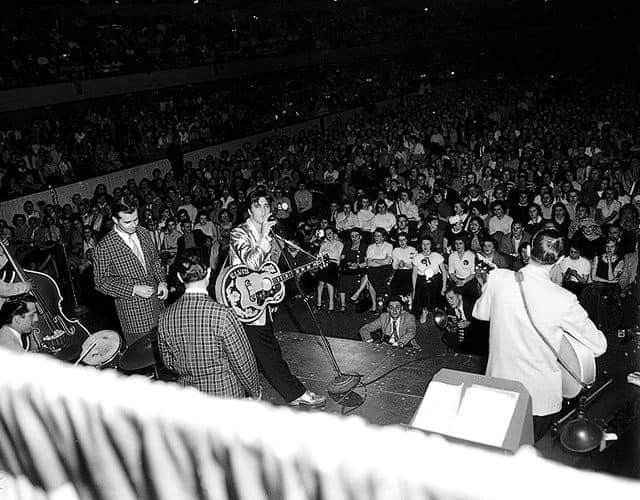THE BILLBOARD IN 1956
This year 1956 will undoubtedly be the year of change in music. Record sales increased dramatically, going from 100 million dollars in 1955 to 277 in 1956, and American society was beginning to see a change led by an Elvis who swept the charts this year, taking over the first positions, being the maximum musical figure of the moment.
(adsbygoogle = window.adsbygoogle || []).push({});
The Billboard charts were a true reflection of the Rock n’ Roll phenomenon, and the definitive consolidation of this genre that came as a breath of fresh air. Aside from Elvis, other artists also contributed to its ultimate explosion. A few examples are Carl Perkins with “Blue Suede Shoes“, Little Richard with “Long Tall Sally” or “Rip It Up“, also Bill Halley with his Comets and his hit “See You Later Alligator” or “Roll Over Beethoven” by Chuck Berry.
 |
| Chuck Berry, 1956 |
Other top hits of the year were Fats Domino‘s “Blueberry Hill” (#2 Top 100 and #1 R&B chart with “Blue Monday“). Another who stood out this year was Gene Vincent with “Be Bop a Lula.” After this success his career took a nosedive, dying of alcoholism in 1971 at the age of 31.
Throughout his career Elvis covered many of these songs. Meanwhile on the Country charts we find Johnny Cash and “I Walk The Line.” This is one of the first songs Johnny Cash recorded with Sam Phillips at Sun studios. Eddie Arnold was also a hit on the charts with “You Don’t Know Me.” Elvis recorded this song in 1967 for the soundtrack to the movie “Clambake.“
(adsbygoogle = window.adsbygoogle || []).push({});
Rock n’ Roll was the symbol of the change of an American youth already tired of so many singers with bow ties and the bourgeoisization of their parents. Now they wanted to be like James Dean or Marlon Brando, or like Elvis himself. This social change is reflected in record sales, in the world of cinema where films such as “Rebels Without a Cause” by James Dean or “Marked by Hate” by Paul Newman are shown, films with a markedly rebellious and non-conformist style.
[youtube https://www.youtube.com/watch?v=wXRgAXU1-T4]
The change can also be seen in fashion, with jeans and leather jackets replacing the suit and tie. In short, a society in which an old way of thinking was mixed with this new way.
Other performers who could fit into this Rock n’ Roll sack, although they may be more decaffeinated than those mentioned above, were, for example, Pat Boone who was at the top of the Billboard chart for two weeks with “I Almost Lost My Mind “, the 1950 composition by Ivory Joe Hunter, or Jim Lowe with his “Green Door” for three weeks (Shakin Stevens brought it back to number 1 in England in 1981).
(adsbygoogle = window.adsbygoogle || []).push({});
But Elvis Presley was the great winner in this year 1956 being number 1 with “Hearbreak Hotel” for 7 weeks, as many with “Don’t Be Cruel” and adding two more with “Love Me Tender“.
Another one who did pretty well this year as well was Dean Martin who was at the top for 5 weeks with “Memories Are Made Of This“. The vocal quintet “The Platters” also triumphed, two weeks at the top with the song “The Great Pretender” (a song that Freddy Mercury covered without his Queen companions in 1987 and which led to number 4 in England) and added 4 weeks with “My Prayer“.
Also at the top was Tennessee Ernie Ford, a country singer turned TV host who was very successful in the 50’s, he was number 1 for a week with the song “Sixteen Toons“. Also the jazz singer Kay Starr was at the top for 3 weeks with “Rock and Roll Waltz” and Lex Baxter with the song “The Poor People of Paris” was number 1 for 6 weeks.
Another two greats in this 1956 were Gogi Grant with the country theme “The Waiwad Wind” and the Detroit singer Guy Mitchell with the song “Singing the Blues“.
(adsbygoogle = window.adsbygoogle || []).push({});
In short, as you can see, a mixture of tastes and styles that were marking the way of thinking, being, and seeing life in North American society, a society that was increasingly confronted and divided, a society that, for better or worse, , was changing, and this was something that no one could stop anymore.
Elvis was undoubtedly the standard bearer of this change, which is why for some he was the example to follow, while for others he was public enemy number one, and as shown, you can see it in the following video of Elvis performing “Hound Dog” on the Milton Berle show (1956).
[youtube https://www.youtube.com/watch?v=Ela9Hfhhyds]
Article written and provided by Cesár Valle (Spain)
(adsbygoogle = window.adsbygoogle || []).push({});









